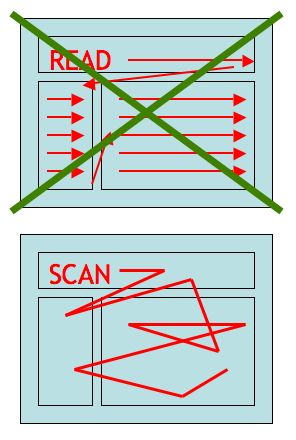5 Psychological Secrets of the Human Mind Every Marketer Should Know

What does psychology have to do with marketing? With design?
Everything.
Read time: 12 minutes
A fundamental rule of marketing is to understand your audience. But how can we really know them if we don’t understand how our own brains work? What impulses motivate us to make decisions?
We really need to know the psychology behind our buying decisions to be able to make the right campaign and design choices.
1) Can I eat it? Can I mate with it? Will it kill me?
Let’s get right down to the basics of human psychology.
On this base level, we’re programmed to ultimately care about three things:
- “Can I eat it?” – because without food you’ll die
- “Can I mate with it?” – because without mating the species will die out
- “Will it kill me?” – because if that happens, then the other two questions don’t really matter anymore.
What this means is that you’re unable to resist noticing food, sex or danger, no matter how hard you try to prevent yourself.
Example: here’s a lovely picture of a gorgeous plate of food. This image most likely drew the attention of your eyes before anything else. More annoyingly, your eyes probably keep being drawn to it periodically.

Obligatory Avocado
You see, due to our evolutionary history, we’ve developed a set of three different brains, all stacked up on top of one another.
- The New Brain – the fancy Lamborghini part of your brain. Where your conscious decision-making is housed. Your reasoning and logical part (we’ll also admit that this brain thinks quite highly of itself; thinking it’s better than its older siblings).
- The Mid-Brain – This is the part where your emotions are processed. How you feel about certain things.
- The Old Brain – Food. Sex. Danger. That’s all this brain cares about. This brain developed first and its basic purpose is to just keep you alive!
The old brain constantly scans inputs from your various senses of potential food, mates or dangers. When it spots any, it will notice and be drawn to them whether or not you want to or not.
But just because you notice it, it doesn’t mean your brain is still primitive enough to want to eat the picture of the food.
And that’s because your old brain is complemented by the new and the mid.
Take rubbernecking for instance.
Have you ever moaned about the fact that people slow down and gawk at accidents? On the other hand, do you ever find yourself also glancing over? Like an unconscious reaction? You know you shouldn’t, but your eyes are drawn?
That’s a typical battle between your brains. Both your mid and your new have an emotional and logical reason not to want to look. Both have an emotional and logical reason to be disgusted at others doing it.

To war!
But your old brain doesn’t care about any of that.
It wants you to survive and it has spotted danger.
It wants to evaluate what the danger is so that it knows that you are safe.
So. What Does This Mean For Marketing?
I’m not suggesting for a moment that every campaign should involve food, sex or danger. The majority of businesses will always struggle to accommodate them in any campaign.
But, if you are able to use them, you’ll be able to get a lot of attention because you’re talking to a very primitive and powerful area of the brain.
The danger factor is the most interesting takeaway.
Indicating to your audience what dangers or threats they could face without your product/service will be understood by your old brain before any other areas. Simple and clear communication of what the danger/threat will be is vital.
2) If you’re sexy, you’re trustworthy… unless you’re an idiot.
Sorry to break the news to you but we’re quite shallow creatures really.
Firstly, did you know that there isn’t that much research or data out there about any correlation towards design and credibility?

Come on science! What do you think you’re playing at?
Fascinating really. The industry is full of opinions, but not necessarily actual raw data.
It probably stems from something discussed in an earlier article which highlights that great design tends to be invisible. As a result, the industry notices bad design but not enough good design.
Saying that, what research has been conducted reveals some amazing insights that actually evidence that great design really is invisible.
In 2004, researcher Elizabeth Sillence conducted a study into health websites.
Her research was to uncover how people decide which websites to trust.
Quite simply, the participants had to rank whether a site was trustworthy or not. Afterwards, they commented on the reasons they rejected a website.
Astonishingly, out of the reasons to reject a website, 83% of the comments focus on design factors. Areas including poor navigation, colour, text size. Even the name of the website played a part.
It gets better though!
When asked to comment on the reasons they believed why a website was trustworthy, the design wasn’t even considered a major factor.
Trustworthiness was influenced by the content of the site and the writing style that it had.
What does this mean?!?!?!
What this means is that we rank trust in subconscious stages. But stages we as marketers have amazing control over.
We first trust things based on how it looks. And when it looks great we then concentrate on what and who is actually saying it.
It is important to note that when it looks great, we don’t even notice it. It becomes invisible to our senses.

Robert is so attractive that you won’t even notice his face.
Let’s get back to food.
Imagine picking up a juicy looking apple.

This apple looks good enough to eat!
Your first step is to judge whether the outside looks good enough to eat.
- If the answer is yes – you bite into it.
- If the answer is no – you chuck it.
Step two is taking a bite and considering whether it tastes as juicy as it looks.
- If the answer is yes – you carry on eating it.
- If the answer is no – you’ve been lied to and the apple must be binned!
Essentially you judge its health based on appearance first, then on its contents.
So What Does This Mean For Marketing?
Design matters. To incredible depths.
We literally do judge books by their cover.
It is a variable that you have an incredible control over. Invest a sensible amount of time and research to ensure that the colours, navigation, text… everything is effective.
Exploring User-Experience and User-Interface is vital in ensuring that your design is seamless.
You want your design to be so incredibly good, that no one even notices it. It blends seamlessly and gives your audience absolutely no barriers.
Then you can move onto ensuring your content is right.
Talking of which…
3) Abracadabra, my words are like magic
English is a beautiful language. It’s charming, graceful, exquisite, artistic, divine, magnificent, engaging and can even be irresistible when used in particular ways.
With 171,476 words in use, 47,156 obsolete words and 9,500 derivatives (according to the Oxford English Dictionary), it’s a beast of a language.

Pictured: some words in the wild! Watch how they flock together in an almost poetic way.
Marketers should rub their hands in glee by how many combinations of words that can be mixed together.
Words are incredibly powerful.
Words can change meanings and motivations.
Words even have the power to change your memory!
In 1974 Elizabeth Loftus and John Palmer investigated whether there was an interaction between language and memory.
Participants were asked to watch various video clips of car accidents. Following this, they would be asked a series of questions about each accident. However, critical words would be substituted. For example, they might be asked “How fast were the cars going when they smashed into each other?” or “How fast were the cars going when they hit into each other?”
What they discovered is that by using the word smashed, the participants estimated that the speed was higher. Essentially, people’s memories changed because of the words used.
This just highlights how powerful words can be. But out of 200,000+ words in the English language, how many do you truly believe are important? How many can be used to persuade people to buy your goods or services?
When you start to investigate which words in the English language are the most persuasive, you will find countless different sources. I’ve seen lists from 700 to 6,000.
In all honesty though, in all the research, there are only two words that really stand out.
The Most Important Word is “You”
Why? Because people are selfish of course!
People are ultimately interested in fulfilling and satisfying their own needs.
“Remember that a person’s name is to that person the sweetest and most important sound in any language.” – Dale Carnegie
When you talk to them, you have to reference them. Using the word ‘you’ speaks directly to your audience, to the individual themselves.
…And In A Very Close Second…
Because.
This word has a fascinating effect on the human mind.
Like, crazily so.
One of the greatest studies into this words power was by social psychologist Ellen Langer in 1978. She performed an experiment where she asked to cut in line to use a copy machine.
There were three different ways of asking;
“Excuse me, I have five pages. May I use the Xerox machine?”
Here, 60% of the people asked responded with OK
“Excuse me, I have five pages. May I use the Xerox machines because I’m in a rush?”
Introducing a rational reason with the word because boosted the effectiveness to 94%. Nearly 100%. An amazing response.
But there was a third way too…
“Excuse me, I have five pages. May I use the Xerox machine because I have to make some copies?”
93% said ok. A 1% drop from the second version for a, let’s be honest, not the greatest reason.
As the trigger word ‘because’ is so extraordinarily powerful, it doesn’t necessarily matter what the value, reason or rationale that follows it is. Just that there is a reason.
So. What Does This Mean For Marketing?
There are some bite-size pointers that can really be introduced to your marketing:
- Address your audience’s pain in a way that the old brain understands
- Speak to them directly using the word ‘you’
- Give them a reason ‘because’ (and the value behind the reason doesn’t really need much thought, just as long as there is a reason)
4) We’re lazy
We’re lazy.
Really lazy.
But, that really depends on your definition of lazy.
We’re also incredibly efficient as a species. We find the quickest and easiest way to complete tasks with the least amount of effort.
You, and I, and everyone we know make decisions based on a principle called satisficing. A term coined by Herbert Simon to describe our decision-making strategy. How we tend to pick options that are more adequate rather than optimal for our needs.
The basic idea is that we just don’t have the brain power to weigh up all the options.
Take Netflix for example.
How many times have you opened it up with the intention of watching something new? Then you scroll through and through and through loads of different options to pick something. All the films, TV shows, documentaries.
Before you know it, you’ve been scrolling through hundreds of options.

Pretty much like this image. Too many choices = too many possibilities. Which one do you choose?!
The result: you end up turning Netflix off and watching Love Island on ITV2 instead.
It’s essentially impossible for your mind to do a complete analysis of all the options. And the result of it is making a decision based on “what will do”.
This behaviour is best represented by the infamous Jam experiment about how choice overload makes us buy less.
Not heard of it? Well, in 2000, psychologists Sheena Iyengar and Mark Lepper decided to venture into the realm of jam-selling. But, being psychologists, they had ulterior motives.
On a regular day at a local food market, they set up a stall with 24 different kinds of jams.
On another day, at the same market, they set up a stall with only 6 varieties of jams.

Jams! So many Jams! How do I ever decide?!
The results were unexpected.
Iyengar and Lepper found that while the stall with 24 jams generated more interest, people were far less likely to make a purchase. More people purchased when there was less choice.
This all has to do with the fact that choice paralyses the consumer.
So. What Does This Mean For Marketing?
We should design and market based on satisficing.
Whilst lots of options sounds good, it paralyses us. Forcing us to make the most optimal choice for our needs. It causes us to take longer to make a decision and, in some cases, even stops us from even making a choice.
Consider how people will look at your design. Take website design for instance.
Whilst we might think providing lots and lots of information on a webpage will be useful for a consumer, in actuality, it might paralyse them.
This would result in them scanning a page rather than consuming all that information.

How we wish people would read website pages vs. how they really read them. Especially after you’ve written a 2900 word article…
The result of scanning means they fail to grasp key information. Failing to grasp key information might mean they fail to convert, get in touch or make a purchase.
Say you’ve written a webpage with over 500 words on it. Does it need that many words to convey your message?
Can you re-write it in 250 words?
What about 125 words?
Design with the intention that you can convey your product in the shortest possible way. Reduce choice. Be succinct.
5) Time is money.
In business, it can be seen as an easy-win to assume that if you sell something cheaper then you’ll sell more of it.
But think about it for a moment.
Is money really a motivator?
Does the cost of something really matter when you make a purchase?
If the cost of a product matters, then Apple wouldn’t have just become a $1 trillion valued company.
If the cost of a product matters, then fine-dining restaurants wouldn’t compete against McDonald’s.
If the cost of a product matters, then Quaker Oats wouldn’t exist when it’s essentially just oats. Oats of which you can buy a big bag of for only 75p at Asda. Why do people buy Quaker Oats when there are cheaper options?! It’s just oats! I don’t get it… actually, that’s a lie. I do get it. It’s just frustrating!

Why people pay so much for a bowl of this. It’s oats! Just oats!
So. If cost doesn’t matter to the sale of purchases, why do the reasons like “it’s outside of our budget” or “you’re too expensive” exist?
It’s all to do with not knowing your audiences’ subconscious motivators.
We assume that money is the biggest motivator. But it turns out that time could be a bigger motivator (for the majority of people at least).
In 2009, Cassie Mogilner and Jennifer Aaker from the Stanford Graduate School of Business ran experiments to see whether references to time or money would affect purchasing behaviour.
They ran a lemonade stand over the course of a few days to investigate. Each time they changed the signage. “Spend a little time, and enjoy C & D’s lemonade”, “Spend a little money, and enjoy C & D’s lemonade”, and for control “Enjoy C & D’s lemonade”.
The results saw that twice as many people stopped when time was mentioned than money. They also found that those that stopped based on time were more likely to spend more on average.
Interestingly, the control measure saw higher results than when money was mentioned.
This means that mentioning time brought in more customers and more money, whilst mentioning money brought in the least money.
Mogilner and Aaker hypothesised that mentioning time you end up making more of a personal connection than you can with money. And as social creatures, we seek out personal connections.
This hypothesis also rings true in regards to Dr. Thomas Gilovich’s 20 years’ study on happiness. His studies have explored the assumption that spending money on possessions increases happiness more than experiences.
A conclusion indicates that buying from experiences can be a higher motivator than money.
It’s the reason we rationalise spending on going on holiday yearly when, in actuality, that money could be well spent on other areas.

A sunny beach? I’m sold.
So. What Does This Mean For Marketing?
If most people make purchases based on experiences, then give them an experience.
Think about how you pitch the experience.
What personal connection you can make with your product/service that enhances an experience.
Advertise on the benefit of time or experience rather than the cost.
Case in point; I recently got a Google Home. Absolutely no reason why. It’s not add anything to my life. I didn’t need one.
But, it’s super awesome. I’ve hooked it up to all my lights. Meaning I can just go “Ok Google. Turn off the lights”.
I can get it to turn my TV on. I can set reminders. Add stuff to my shopping list.
All sorts.
…The truth is, I’ve not even used it for two months.
So why did I buy it?
Because of the experience the adverts showed me. The time I could save with it.
They generated a personal connection with me and they won.
Damn them.
Understanding how we as humans operate helps us market. It tells us that we have simple impulses, but also complicated ones.
Taking science and research into design and marketing principles means we can create with a purpose. We can create campaigns with increased effectiveness.
Ready to get started?
Our team of creatives work together in a wide range of disciplines, meaning we’re able to craft beautifully bespoke creative that will produce results you’ll love!


